It’s always nice when someone gets in touch and offers you an unsolicited review of a gig or album. Graham Jackson works in artist services, looking after artists touring the UK among other things. He’s also a very interesting guy to chat with – he has a few stories. This is his take on Isabella Coulstock supporting The Jools Holland Rhythm and Blues Orchestra at Warwick Arts Centre.
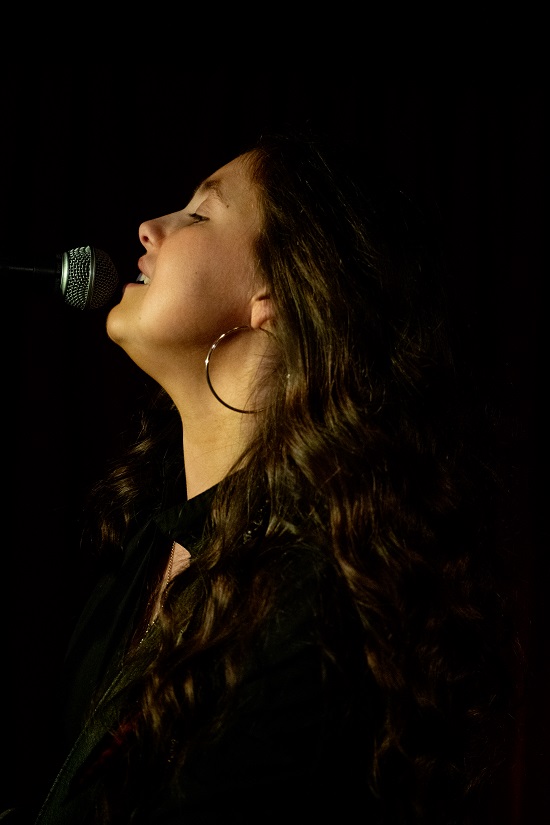
21st May 2023 – Warwick Arts Centre – Jools Holland with support by Isabella Coulstock
A reflection on a first visit to the impressive 1,450 capacity Warwick Arts Centre that is modern, spacious, scrupulously clean with facilities including a bar/restaurant to match.
The auditorium itself is wonderful. Despite its sizeable capacity, there is a feel of intimacy as the balconies wrap themselves around itself even going behind the stage area.
The time for the opening artist, Isabella Coulstock, is approaching and so refreshing to see the auditorium is near full in anticipation of the show, the Jools Holland audience showing a respect and interest in the support artist, perhaps with some naivety and curiosity.
The scene is set. The lights dim except for the one white spotlight, the announcement made, “Ladies and Gentleman, please welcome Isabella Coulstock” and as she walks on with her guitar, the audience breaks into spontaneous applause. Then silence as Isabella prepares herself.
With confidence and a big smile, Isabella starts her set with ‘Nice Just Ain’t A Good Colour’ which serves to give an immediate impact and connection with the audience. They are listening and listening with genuine interest, impressed from what they are seeing and hearing. It works – rapturous applause.
A set of six self-penned songs, from the very first written ‘Crazy Cowboy’ to the brand new ‘Riverside’, each appealing to the audience whatever the tempo, ultimately finishing with some audience participation which they duly join in singing and clapping to ‘Honky Tonk Beer’.
Isabella’s wonderful pitch-perfect vocals and accurate guitar play were ‘talking’ to and enchanting the audience, interspersed with short song introductions and thanks to Jools Holland and his team. It was the audience that was thankful, mutterings heard through the show such as “wow, what a voice” and “she is something else”, even comments after saying “the new KT Tunstall”.
Isabella Coulstock is like one of those rare beautiful orchids that takes time to develop and when the time and conditions are right, it blooms into a wonderful show of colour and panache – the show proved that the time and conditions are right for Isabella.
Full Set List:
- Nice Just Ain’t A Good Colour
- Borderline
- Broken
- Riverside
- Crazy Cowboy
- Honky Tonk Beer
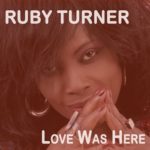 Twenty albums in twenty years; that’s not bad going, particularly when you have a day job fronting up for Jools Holland’s Rhythm and Blues Orchestra. You probably know that Ruby Turner has a fabulous voice, but she’s much more than the chanteuse with Jools Holland; Ruby Turner is a genuine British soul phenomenon with a career stretching back into the mid-eighties and some astonishing live and recorded performances (if you haven’t already heard it, check out her version of “Stay With Me Baby”). So, what’s the deal with Ruby’s latest album, “Love Was Here”?
Twenty albums in twenty years; that’s not bad going, particularly when you have a day job fronting up for Jools Holland’s Rhythm and Blues Orchestra. You probably know that Ruby Turner has a fabulous voice, but she’s much more than the chanteuse with Jools Holland; Ruby Turner is a genuine British soul phenomenon with a career stretching back into the mid-eighties and some astonishing live and recorded performances (if you haven’t already heard it, check out her version of “Stay With Me Baby”). So, what’s the deal with Ruby’s latest album, “Love Was Here”?
A couple of things; this is mainly about Ruby recognising the influence of the people she listened to as she grew up and trying to create the feel and grooves of those artists without creating carbon copies. The second thing is that Ruby has pulled together a fabulous soul band (mainly from Sheffield, a very fertile ground for British soul musicians). The band is: Kat Eaton (backing vocals), Nick Atkinson (guitars), Joe Glossop (keys), Jeremy Meek (bass) and John Blease (percussion) – Google any one of them and see just who they’ve worked with. This is a quality outfit, and they do what quality outfits do; they create arrangements that support the song and the vocal perfectly without any fuss or showboating.
The songwriting team is Kat Eaton and Nick Atkinson and between them they pull off the very clever trick of creating a groove and style that suggests a particular artist while still sounding fresh and original. Of course they have a huge advantage in that the songs are being delivered by one of the UK’s finest soul voices. The songs and the arrangements pull in structural elements from the styles they’re emulating; there are a lot of examples of the old gospel technique of call and response, not just with vocals but also between instruments as well. The other technique that appears a lot is unison playing in various instrumental configurations.
You can listen to the songs yourself and work out which song is influenced by which musical hero; there are nods in the direction of Al Green, Curtis Mayfield, BB King and Ry Cooder mentioned in the sleeve notes but you’ll also find references to Marvin Gaye, Sam Cooke and Otis Redding (and probably many more if you dig deep enough). It’s a fitting tribute to the pioneers of soul.
“Love Was Here” actually started life as an EP with four or five songs, but gradually grew to full album status over a period of eighteen months. The songs hang together well and it’s generally a coherent piece of work, apart from the bonus track “Chasing Love” from the film “The Host”. It’s the only song that wasn’t recorded at The Foundry in Sheffield and it’s very different, featuring a haunting solo violin and orchestral backing. It’s not better or worse than the other ten songs; it’s just very different.
“Love was Here” is the sound of great musicians lovingly evoking their musical influences, fronted up by a great British soul voice and it’s out now.
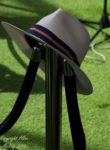 This started the way the best features do, as a conversation in the pub. We’ll let Allan take it from there.
This started the way the best features do, as a conversation in the pub. We’ll let Allan take it from there.
It’s one of the oldest tricks in the pop music book; if the song’s on its last legs and you still need another thirty seconds or so to get you up to the optimal time for radio play, then you deploy one the producer’s most potent tactical weapons – the trucker’s gear change. In its most basic form, the whole arrangement shifts up a tone or a semitone, to grab back your attention before the chorus repeats and fades. Usually, it just happens once, but that depends on how desperate you are (or how weak the song is). You might even get some clever stuff going on to get from one key to the next; when that happens, you get all classical and call it a modulation. What do they sound like? Let’s start with an absolute clunker.
“I Will Always Love You” – Whitney Houston
Considering the quality of the musicians available to producer David Foster, this TGC is bone-jarringly unsubtle; there’s no attempt to pretty it up by repeating a riff in the new key or moving through a few passing chords. Oh no; old key/bang/new key – we’re done. As if that’s not enough, there’s a whole bar of almost complete silence before the melody crashes back in again, maybe David Foster thought that the average listener couldn’t remember which key the song was in after 4 beats. Who knows; anyway it’s a crash/bang/wallop of the highest order and you can hear the teeth grinding off the flywheel:
“Love on Top” – Beyonce
OK, we’re now well and truly in the era of digital recording and production and it’s much easier and quicker to manipulate sounds. You can do a TGC with a mouse-click. If it’s so easy to do, why not do loads of them – one is good, two must be better. Beyonce co-produced this with Shea Taylor, so she’s sharing the blame here. In the last ninety seconds of the radio edit there are four, yes four upward key shifts as the chorus is repeated. It makes you wonder what it would be like if the key shift just kept repeating. As it happens, someone thought of that. Here it is with fourteen upward shifts:
“The Snake” – Al Wilson
Ah, the old Northern Soul classic. Fans will remember that one of the UK pressings of this song had a cover of the John Fogerty classic “Lodi” on the b-side. That’s not relevant, just me showing off. Sometimes you can get away with a few stick shifts if you’re building up to the climax of the song and that’s what happens here. At the end of the second verse, there’s a bass riff which is then repeated a tone higher and you’re in a different key. It’s not just a chorus repeated in exactly the same way but higher, it’s part of the process of moving the story along. And the same device is repeated at the end of the third chorus into the final verse as the song reaches its dramatic finale. Maybe I’m biased, but I think this is part of the arrangement of the song and that keeps it out of Room 101:
“Heat Treatment” – Graham Parker & the Rumour
You might think that any key change part way through a song would be agreed with the writer; it ain’t necessarily so. This was the title song of GP and the Rumour’s second album “Heat Treatment”, released in 1976, the same year as his debut “Howlin’ Wind” (two albums in a year and incessant gigs; musicians grafted in those days). Partway through the song, there’s a modulation; it’s quite musical – a two-bar horn section phrase takes the song up a tone. It’s not lumpy but it does the job fairly quickly. The problem is that it’s not part of generating extra excitement, just the opposite. It takes the song into a bass riff breakdown and the groove has to be built up again from scratch. Graham Parker made his feelings about it known when the album was remastered for CD; his sleeve notes refer to it as ‘that abusive key change’. Fair enough.
“Up the Junction” – Squeeze
This was the title track from the second Squeeze album, with a tip of the hat to Nell Dunn who wrote the novella of the same name. Glenn Tilbrook and Chris Difford were just beginning to realise their potential as songwriters and Jools Holland was still their keyboard player. This is a key change that is about as far from a trucker’s gear change as you can get. It’s a modulation that reflects a downbeat turn in the lyrics through a ten-bar bridge using minor chords before dropping a whole tone for a more upbeat verse and then, paradoxically, going back up by a whole tone for the downbeat final verse. Difford and Tilbrook characteristically messing with the conventions. Bits of “Up the Junction” trivia? There are no choruses and the title of the song doesn’t appear in the lyric until the last three words:
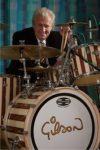 Exactly a year ago we published an interview with Gilson Lavis about his second career as an artist, running parallel with his day job as drummer with the Jools Holland Rhythm & Blues Orchestra (and let’s not forget Squeeze, where he got his first taste of fame). The interview concentrated on the upcoming exhibition of his artwork at the Salomon Arts Gallery in New York; a year later it’s time for London to play host to his evocative images. If you missed the interview, here’s a quick recap (with a few examples of Gilson’s work).
Exactly a year ago we published an interview with Gilson Lavis about his second career as an artist, running parallel with his day job as drummer with the Jools Holland Rhythm & Blues Orchestra (and let’s not forget Squeeze, where he got his first taste of fame). The interview concentrated on the upcoming exhibition of his artwork at the Salomon Arts Gallery in New York; a year later it’s time for London to play host to his evocative images. If you missed the interview, here’s a quick recap (with a few examples of Gilson’s work).
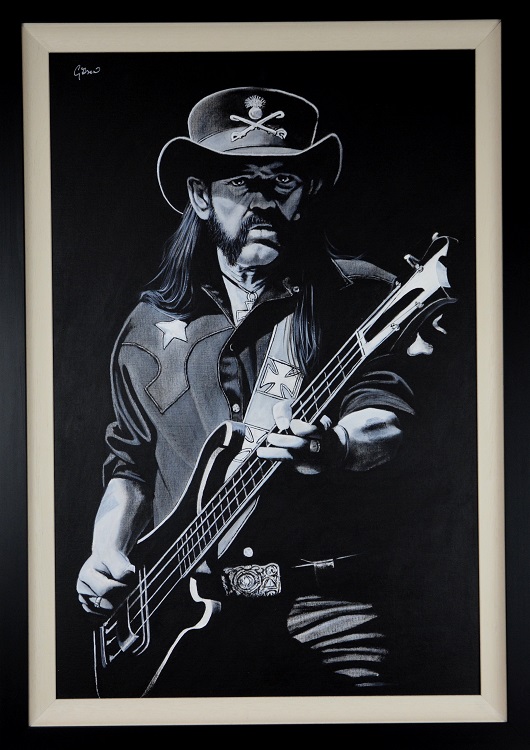
As Gilson’s musical career developed, he made use of his leisure time on tour in a constructive way; instead of the usual rock ‘n’ roll recreations, he went back to drawing and painting using the material closest to him; musicians. The day job (particularly with Jools Holland’s Rhythm & Blues Orchestra) gave him the opportunity to see of the world’s greatest musicians at close quarters and he’s made the most of it, creating some fabulous works of art that he’s now exhibiting and selling. In addition to the personally-observed pieces, there are also pieces created from photographs of performers as diverse as Ray Charles, Tony Hancock and Jimi Hendrix.
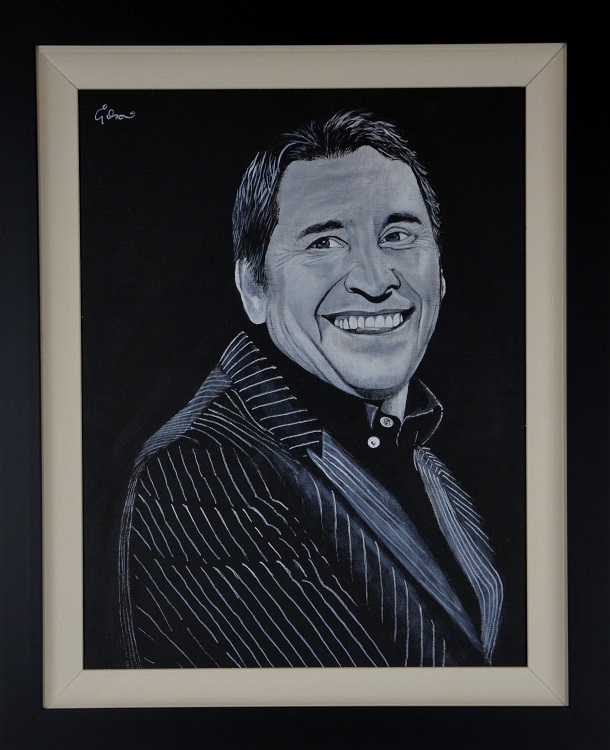
So, back to 2018 and Gilson has a London exhibition, “Gilson Lavis: From Drums to Canvas”, at the Karma Sanctum Soho Hotel from July 5th to August 12th. It’s a must-see event, but don’t take my word for it, here’s Gilson’s take on the exhibition: “I am thrilled to have the opportunity to show some of my artwork at the Karma Sanctum Hotel in Soho. The ethos of the venue and the subject matter I focus on in my paintings combine superbly well. A great venue and a great privilege. I can’t wait !”
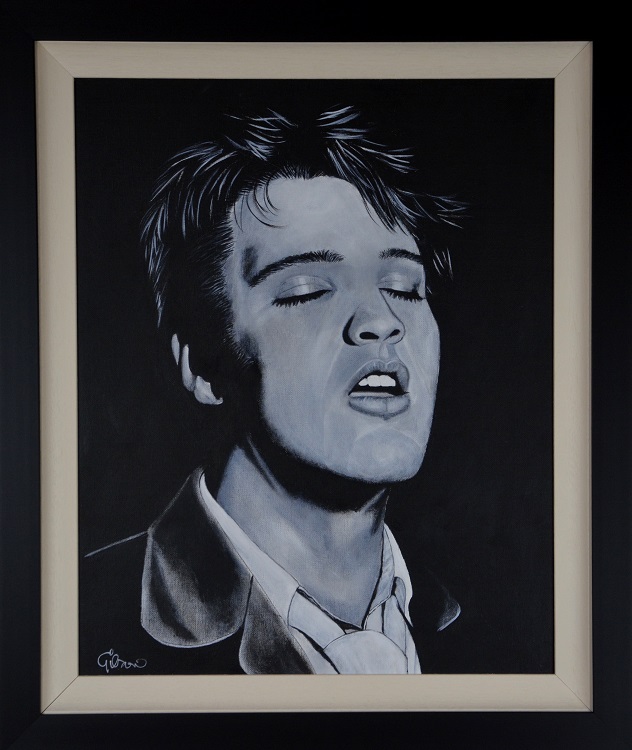
My advice is to get down to the Karma Sanctum to see this exhibition; apart from the unbelievable quality of Gilson’s work, you never know who you might bump in to admiring their likeness. And if you bump in to Gilson, say hello to him; he’s a lovely guy and he has a huge store of music business anecdotes.
 By an interesting series of coincidences, I found myself backstage at a Southside Johnny & The Asbury Jukes gig at The Forum in Kentish Town pointing the trusty MusicRiot microphone in the direction of Gilson Lavis. If you have any interest at all in popular music, you must have heard of Gilson in one of his two musical careers; he’s a great and highly respected drummer but I wasn’t there to talk about his music; we don’t do the obvious stuff like that at MusicRiot. I was there to talk to Gilson about art. There’s a reference at the end to Johnny stealing my thunder; he voicebombed the interview about a third of the way in to talk to Gilson about how much he loved Squeeze.
By an interesting series of coincidences, I found myself backstage at a Southside Johnny & The Asbury Jukes gig at The Forum in Kentish Town pointing the trusty MusicRiot microphone in the direction of Gilson Lavis. If you have any interest at all in popular music, you must have heard of Gilson in one of his two musical careers; he’s a great and highly respected drummer but I wasn’t there to talk about his music; we don’t do the obvious stuff like that at MusicRiot. I was there to talk to Gilson about art. There’s a reference at the end to Johnny stealing my thunder; he voicebombed the interview about a third of the way in to talk to Gilson about how much he loved Squeeze.
Allan Hi Gilson. Some of us know you as the drummer in Jools Holland’s Rhythm and Blues Orchestra, The older ones know you as the drummer in Squeeze, but now you’ve got a new career as an artist, so how did that start?
Gilson Well, it started out of boredom really. I lead a pretty clean life these days; I don’t drink or any of the other stuff, thankfully and hanging about on the road or hanging about in hotel rooms, I’ve been doing it for about fifty years now, and it started to get a bit wearing, so I started to doodle and the doodles turned in to sketches and the sketches turned into paintings and now the paintings have turned into exhibitions. So it just sort of grew really and I’m in a very privileged position because with my position in the Rhythm and Blues Orchestra we get to play with some of the world’s best entertainers and performers and I see them close at hand and I try and paint them, and I think I can capture some of the real essence of the person.
Allan You had an art school background didn’t you? Did you continue to draw after you left art school and joined Squeeze?
Gilson No, I went straight into music, the driving force being sex; I wanted to pick up girls. It never really worked, but I got into the music business and I’m still doing that so the art was just put away really. I didn’t pick up a sketch pad or an easel or a paintbrush until about ten years ago, when I started again.
Allan Do you think you choose your subjects or do you think they choose you?
Gilson It’s a mixture of both really. As I said, I tend to sketch and paint people that I work with and sometimes I’ll get inspired by an image I see of somebody and I’ll paint from that, but really it’s working with these people that’s the driving force.
Allan You’re working mainly in acrylic on canvas aren’t you? Do you work in any other media?
Gilson Yeah, I do. I do ink sketches. That’s really what I do on the road, sketch in ink, but when I’m at home, I’ve got a large studio and my own gallery, so I paint at home and sketch on the road.
Allan In the creative process, do you have certain steps that you follow? I’m thinking of the preparation; I saw the Louis Armstrong sketch that you did and obviously you couldn’t do that from life so presumably you researched that online.
Gilson I do actually. A lot of the people I’ve painted or sketched, they’re too busy to sit for me; they’re not going to come round to my house and sit, so I do have to sketch from images. I try to take photographs when I’m working with them and sketch or paint from those, but it’s not always possible, because some of these people like Louis are no longer with us, I have to research them and I look for images that are inspiring and I tend to blend three or four images to get the look that I’m searching for, so it sort of grows.
Allan I’ve met quite a lot of musicians who have other artistic pursuits, painting, photography and so on. Do you think it’s a bit of a release valve?
Gilson I’m sure it is, it absolutely is. Though it’s a real privilege to work with the Rhythm and Blues Orchestra; it’s high profile and we play big venues, but it is quite a restrictive environment. I’m there to make Jools sound good, I’m there to make the big band work, I’m not really cutting loose on what I want to do and the painting really allows me to be creative.
Allan So the band becomes the day job and your creative outlet is the painting.
Gilson But it’s a very enjoyable day job, I’m in a very privileged position.
Allan I’m fascinated by the paintings and the way they reflect the personalities of the people you’ve portrayed and it struck me that they’re not hyper-realistic, but they’re a long way from caricature, aren’t they? The one that particularly struck me, and I wonder how people will react to it, was Keith Moon, because he has a really serene look in that portrait.
Gilson Well, thank you. There are many, many images of Keith being crazy, that’s what he’s famous for, but I really wanted that sort of innocence of the young lad before he went on that crazy journey. I think that’s what I was aiming for, that innocent, lost look, not even knowing what’s going on. What went on of course was craziness and death in the long run.
Allan That was what immediately grabbed me about that particular image, the innocence. I understand that you’ve got a book of some of your images out as well.
Gilson Do you mean the one with the drummer portraits?
Allan That’s the one.
Gilson It was released two months ago actually. It’s eighteen portraits of drummers that have influenced me with a short snippet of a quote by each of them. I was asked many times, who influenced me as a drummer and eventually I thought “I know, I’ve got a good idea, what I’ll do is I’ll paint my influences and put them in a book” and it seems to have worked really well, it’s popular and it’s selling quite well, I’m pleased to say. It’s called “Drummers” by Gilson Lavis.
Allan I understand there’s an exhibition coming up in New York as well.
Gilson There is, yeah, at the Salomon Arts Gallery in Tribeca and it opens on the fourteenth of September. I’m really excited about it; I’ve been fortunate enough to have a few exhibitions in Great Britain but this’ll be the first in New York and I’m really excited by it and a bit nervous, to be honest, because we’re all deeply insecure, us painters, we’re all waiting to be laughed at.
Allan I think photographers are exactly the same. Your career must have had so many highlights, is there anything that really stands out in your memory as a real high point?
Gilson Yes, there is. It was when I was fortunate enough to get the phone call to play drums with Smokey Robinson on Later and on rhythm was Eric Clapton, Jools Holland on piano and Dave Swift on bass and me on drums. In fact there’s a little story about that, we were there, Eric, myself and Jools were there ready to rehearse with Smokey and he was flying in from America and it got to his allotted rehearsal time and we got the message he was a bit tired so he’ll be here in a couple of hours. We all downed tools and waited and then he didn’t show up, he was still a bit tired, and the show started to be recorded and we still hadn’t seen him and I’m sitting behind the drum kit and Eric’s looking a bit sort of worried. We knew the song, everybody know Smokey’s songs. The band before us was playing and thirty seconds before they finished, Smokey Robinson walked out on to the set and I’ve never seen anybody look more like a star than he did; he glistened. His skin was beautiful, his hair was just perfect, he had an incredibly dapper suit; he walked out and I counted the song in and we played it and he was just magnificent and then he turned round and nodded at Eric, he ignored me completely but I don’t mind and off he went and that was it, that was my experience of Smokey Robinson. But it was fantastic, it was a real buzz to play with one of my heroes, and there have been many.
Allan Johnny actually stole my thunder earlier because I was going to say at the end, did you know that Johnny’s a big fan of Squeeze and Jeff Kazee’s also a huge Squeeze fan.
Gilson I didn’t know. I had no idea.
And with that, we had to clear out of the Jukes’ dressing room as the band prepared for the show, but not before Gilson presented Johnny with an ink portrait of Mr Lyon himself. A couple of hours later, Gilson joined The Jukes on stage, taking the drum stool for “Key to the Highway”. And here’s the Keith Moon portrait:
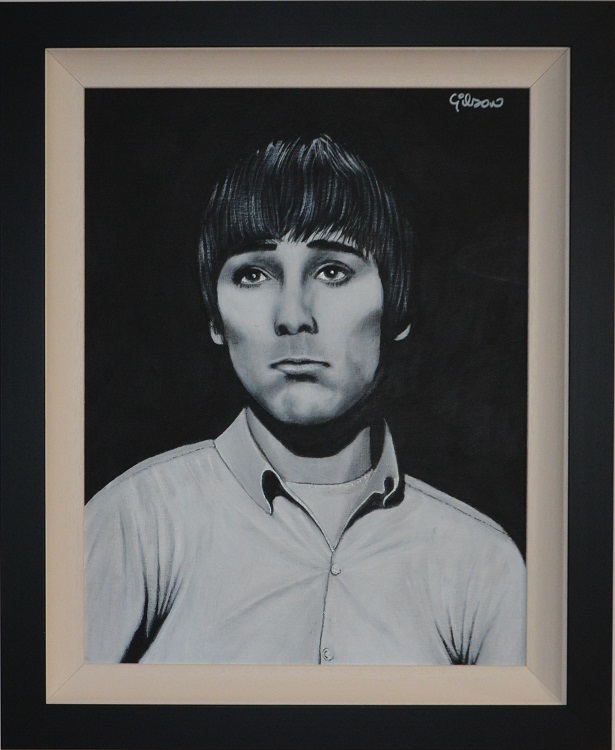
Steve’s been writing for us on an occasional basis for a couple of years now and his work is always worth reading. With this feature, the only stipulation we make is that the list is five items long (and we don’t always get that). Otherwise you can say whatever you like as long as the lawyers approve it. We all love going to gigs and we see a lot of live music and that’s great; we see things that we love. The downside is that the more gigs you go to, the more you see of the things that aren’t quite right. Here are some of those from Mr Jenner’s experience this year:
1) Beer – a tale of five lagers.
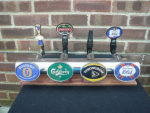 Now, when I go out to see a band, I like a beer. To be honest I like a beer when I don’t go out to see a band as well which is why I also have problems with 4. But for the sake of the good Lord, why, why oh why do some venues insist on dishing up five – count them – five – draught lagers AND NO BITTER? WHY?? Take the O2 Indigo as exhibit A. Gorgeous venue. Excellent sight lines, marvellous acoustics, washroom facilities you could picnic in – and NO BITTER! My most recent visit there was to see Little Steven and the Disciples of Soul and what a breathtaking gig that was. But it also happened to coincide with the night when the Guinness was ‘off’. (What does that even mean? It was past sell-by? It was giving off a sulphurous odour? WHAT?) And so we were offered a wide range of near – identical fizzy light brown chemical substances which could loosely be described as ‘lager’ (and don’t even try to tell me British Bud isn’t ‘lager’). I wasn’t expecting an array of twelve real ales and a couple of nice porters, but – not even John Smith’s, the last refuge of the scoundrel? Bah and humbug.
Now, when I go out to see a band, I like a beer. To be honest I like a beer when I don’t go out to see a band as well which is why I also have problems with 4. But for the sake of the good Lord, why, why oh why do some venues insist on dishing up five – count them – five – draught lagers AND NO BITTER? WHY?? Take the O2 Indigo as exhibit A. Gorgeous venue. Excellent sight lines, marvellous acoustics, washroom facilities you could picnic in – and NO BITTER! My most recent visit there was to see Little Steven and the Disciples of Soul and what a breathtaking gig that was. But it also happened to coincide with the night when the Guinness was ‘off’. (What does that even mean? It was past sell-by? It was giving off a sulphurous odour? WHAT?) And so we were offered a wide range of near – identical fizzy light brown chemical substances which could loosely be described as ‘lager’ (and don’t even try to tell me British Bud isn’t ‘lager’). I wasn’t expecting an array of twelve real ales and a couple of nice porters, but – not even John Smith’s, the last refuge of the scoundrel? Bah and humbug.
2) Music Before The Event.
 Music selection before the band comes on can be a very mixed bag. This seems to vary between ‘let the roadies pick it, we couldn’t care less’, or ‘let’s put the support band’s album on, we couldn’t care less’ through to ‘I’m the bass player and I’m going to treat you to a selection from the very darkest corners of my record collection – a variety of tracks so obscure you’ll only just recognise them as ‘music’, and that means I’ve won….’ I feel pre – gig music choice is deceptively important. It sets the mood and tone and can almost be seen as a statement of intent. Try not to do any of the above. Might I suggest a suitable pre-set approach might be along the lines of; ‘these are the songs written by others that we wish we’d recorded, played by other artists we admire’. That’d do it, generally speaking. Special mention to Brian Wilson at Brighton who seemed somehow to have managed to persuade the ghost of the James Last Orchestra (ask your grandma) to record a medley of his greatest hits. Strangely mesmeric and it worked!
Music selection before the band comes on can be a very mixed bag. This seems to vary between ‘let the roadies pick it, we couldn’t care less’, or ‘let’s put the support band’s album on, we couldn’t care less’ through to ‘I’m the bass player and I’m going to treat you to a selection from the very darkest corners of my record collection – a variety of tracks so obscure you’ll only just recognise them as ‘music’, and that means I’ve won….’ I feel pre – gig music choice is deceptively important. It sets the mood and tone and can almost be seen as a statement of intent. Try not to do any of the above. Might I suggest a suitable pre-set approach might be along the lines of; ‘these are the songs written by others that we wish we’d recorded, played by other artists we admire’. That’d do it, generally speaking. Special mention to Brian Wilson at Brighton who seemed somehow to have managed to persuade the ghost of the James Last Orchestra (ask your grandma) to record a medley of his greatest hits. Strangely mesmeric and it worked!
3) Support Band PA.
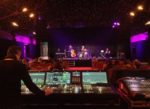 It’s the oldest trick in the Guinness book of gig skulduggery – get your sound engineer to torpedo the mix for the support act. Sure helps you look even better when you come on. But really; do headline bands STILL need to be doing this to the poor souls who have ventured forth to warm up the crowd for them to entertain? We went to see Jools Holland at Ipswich Regent recently. The sound for the support band was so poor that even if my life depended on it I couldn’t tell you the name of the band or indeed the title of any of their songs. OK, maybe it was the band’s own fault, maybe it was nothing to do with the main act’s PA crew. But it still often is, and come on guys, we’re better than this. Especially when the support band has been hand-picked by the headliners because they think they’ve got something. There’s no kindness or even particular advantage in handing over a poisoned chalice. And why headliners keep referring to the poor dears as ‘Special Guests’ whilst abusing them thus is a bit of a laugh. If you were a guest in anyone’s house and they treated you like that you’d be on Facebook like a shot and don’t try to tell me otherwise.
It’s the oldest trick in the Guinness book of gig skulduggery – get your sound engineer to torpedo the mix for the support act. Sure helps you look even better when you come on. But really; do headline bands STILL need to be doing this to the poor souls who have ventured forth to warm up the crowd for them to entertain? We went to see Jools Holland at Ipswich Regent recently. The sound for the support band was so poor that even if my life depended on it I couldn’t tell you the name of the band or indeed the title of any of their songs. OK, maybe it was the band’s own fault, maybe it was nothing to do with the main act’s PA crew. But it still often is, and come on guys, we’re better than this. Especially when the support band has been hand-picked by the headliners because they think they’ve got something. There’s no kindness or even particular advantage in handing over a poisoned chalice. And why headliners keep referring to the poor dears as ‘Special Guests’ whilst abusing them thus is a bit of a laugh. If you were a guest in anyone’s house and they treated you like that you’d be on Facebook like a shot and don’t try to tell me otherwise.
4) Slim Seats (Is Not A Slide Guitar Player).
 I’m sitting on my chair at the rather lovely MEN Arena. As big venues go, it is not a bad watch and very user friendly to get in and out of. If only the same could be said of the chairs. They seem to use this system where the ‘temporary’ seating in the auditorium kind of clips together in a very intimate way; and the chairs are slightly smaller than Ryanair to start with, and they are by no means alone in this. And, as luck would have it, a similarly ‘bonny’ bloke appears to be the tenant of seat K27, the seat which is cheek – literally – by jowl with The Author. Flopping down adjacent to me, spilling one of five types of homogenous lager on my arm and presenting profuse apologies through a mouthful of stadium dog, I’m already feeling my sixty – odd – quid entertainment experience is being compromised. Ken Dodd better be pretty damn good now.
I’m sitting on my chair at the rather lovely MEN Arena. As big venues go, it is not a bad watch and very user friendly to get in and out of. If only the same could be said of the chairs. They seem to use this system where the ‘temporary’ seating in the auditorium kind of clips together in a very intimate way; and the chairs are slightly smaller than Ryanair to start with, and they are by no means alone in this. And, as luck would have it, a similarly ‘bonny’ bloke appears to be the tenant of seat K27, the seat which is cheek – literally – by jowl with The Author. Flopping down adjacent to me, spilling one of five types of homogenous lager on my arm and presenting profuse apologies through a mouthful of stadium dog, I’m already feeling my sixty – odd – quid entertainment experience is being compromised. Ken Dodd better be pretty damn good now.
5) (Ain’t Got Nothin’ But) The Ladybog Blues (Again Mama).
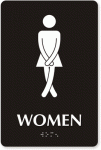 Venues, promoters and bands themselves often bemoan the relative lack of female punters and offer various socio – politico – entertaino(?)- reasons for this. The truth is much simpler. There are not enough bogs for women. It is not rocket science. As a bloke you cruise past, cheerfully unzipping before you so much as reach the door, whilst the queue for the ladybogs has already lit a campfire and are preparing a bivouac for the night. And it’s not even a good chortle for the average bloke; they’re tricky blighters, these women. I know. I’ve been kept by one as a sort of house pet for the last forty years or so. As a token bloke, they hold you personally responsible for all life’s discomforts and they take it out on you as a representative of the foul brood who have brought them to this ignominy. Please, ye great and ye good, if you make one resolution this year, it has to be more ladybogs in music venues. And High Five to you, too.
Venues, promoters and bands themselves often bemoan the relative lack of female punters and offer various socio – politico – entertaino(?)- reasons for this. The truth is much simpler. There are not enough bogs for women. It is not rocket science. As a bloke you cruise past, cheerfully unzipping before you so much as reach the door, whilst the queue for the ladybogs has already lit a campfire and are preparing a bivouac for the night. And it’s not even a good chortle for the average bloke; they’re tricky blighters, these women. I know. I’ve been kept by one as a sort of house pet for the last forty years or so. As a token bloke, they hold you personally responsible for all life’s discomforts and they take it out on you as a representative of the foul brood who have brought them to this ignominy. Please, ye great and ye good, if you make one resolution this year, it has to be more ladybogs in music venues. And High Five to you, too.
I was just drinking my cocoa and keeping up with all the modern trends in music by watching Jools Holland’s “Later” programme last night when I saw something so disturbing that I almost wrote to “Points of View”. On stage, straight after the wonderful Burt Bacharach, were two badly-dressed Northerners with a stolen laptop balanced on a beer barrel and a beer crate ranting, swearing and shouting over the top of what I think they call ‘beats’ these days. My first reaction was (I’ve been dying to try this out) ‘WTF?’ That actually felt quite good, swearing without really swearing. It might just catch on.
Sorry, bit distracted there. The more I watched, the more horrified I became. Why on earth did Mr Holland have two ill-dressed extras from “This is England” on his show ranting and drinking beer (which is very unprofessional on stage, I must say) alongside his usual smorgasbord of high quality modern musicians? At least the Happy Mondays played proper instruments and had something resembling tunes.
So it must be some kind of performance art then or some elaborate joke. Was it a pair of drama students satirising the quality of modern pop music by creating something so obnoxious and unmusical that it was totally unlistenable and then setting out to see how many people they could con. Or maybe it was the media; someone saw an absolutely terrible pair of hip-hop or post-punk, or whatever they are, performers and decided to play the ‘Emperor’s new clothes’ game; tell them how good they are and then build them up in the music press. If you do that for long enough, one of the inkies will pick up the story and bearded Hoxton types will be saying how they loved their earlier work. Amazingly enough, they’ve been doing this for eight years, apparently. The NME does this sort of thing all the time; how do you think Pete Doherty got away with it for so long.
And talking about the NME, what on earth happened to that? I had one thrust into my hand at the railway station the other day; it’s free these days, so I thought I’d check which giants of modern music they were featuring. There was a piece on drug cartels that could have been researched using Wikipedia and the “Ladybird Book of Crack and Cocaine”, the famous music journalist Katherine Ryan (really) writing about Piggate and MeghanTrainor and a six-page plug for the resurrection of Chis Moyles. Just remember that NME used to stand for New Musical Express and this is someone who can get away with playing three songs in an hour. There was once a time when the NME had writers who were vicious, opinionated, clannish and supercilious but at least it was worth reading; I don’t think those days are ever coming back.
But what about Sleaford Mods, you say? They’re not from Sleaford and I’m sure Mr Weller wouldn’t approve of their version of mod couture and they still look like the people I pass every morning waiting for the off-licence to open. I wonder what that lovely Mr Bacharach made of it?
By the way does anyone know of a good product for cleaning cocoa stains off a carpet?


